View in other NatureServe Network Field Guides
NatureServe
Montana
Utah
Wyoming
Idaho
Wisconsin
British Columbia
South Carolina
Yukon
California
New York
Robust Mat Moss - Brachythecium rutabulum
General Description
Plants: Pleurocarpous (Vitt 1988). Growing in slightly open to crowded mats, green, pale green or with yellow or brown tones (FNA 2014), typically shiny (Lawton 1971). Stems prostrate to upwardly inclined, with upright shoots numerous and often close together, leafy, round in X-section, to 10 cm in length (FNA 2014), sometimes stoloniferous (Lawton 1971); possessing a central strand. Branches to 15 mm, leafy, round in X-section (FNA 2014).
Leaves: Stem leaves flat to the stem or spreading a little, overlapping slightly to tightly, a little cupped or sometimes strongly so, faintly longitudinally pleated or not, egg-shaped to somewhat deltoid, widest above the base ca 1/5 of the leaf length or a little less, 1.8-3 mm in length, 0.8-1.6 mm in width; base with wide or occasionally slender decurrencies; margins flat or curved back and downward near the base and sometimes in other locations, apex narrowing to form an acumen of medium length or less; toothed or finely so; costa extending half or more of the leaf length. Branch leaves smaller and more slender than the stem leaves, and with an uneven base (FNA 2014).
Leaf Cells: Alar cells inflated and fine-walled, short, quadrangular, the alar area distinctive; laminal cells long and thin; basal cells arranged in 2-4 tiers (FNA 2014).
Diagnostic Characteristics
Both robust forest species, Brachythecium rivulare has a somewhat tree-like appearance and the sympodial shoots with their branches are not as crowded as in B. rutabulum. Although both species have inflated alar cells, the alar area of B. rivulare also includes cells that are slender and chlorophyllous near the margin, which B. rutabulum does not (FNA 2014).
The similar B. salebrosum has smooth setae rather than rough, and its leaves are generally strongly pleated rather than weakly so or not at all (Crum and Anderson et al. 1981).
Range Comments
North American Range
Canada: BC, ON and east; USA: most northern states from ID east, also in the Southeast except LA, SC, GA and FL (FNA 2014). Known in Montana from Big Horn, Cascade, Flathead, Gallatin, Lake, Lincoln, Meagher, Park, and Stillwater Counties (Elliott 2016).
Observations in Montana Natural Heritage Program Database
Number of Observations: 22
(Click on the following maps and charts to see full sized version)
Map Help and Descriptions
Relative Density
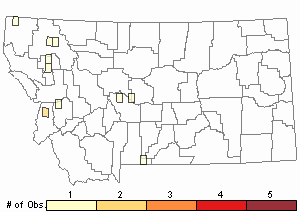
Recency
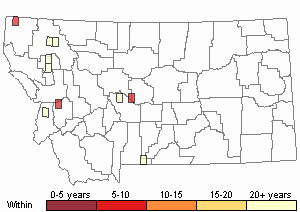
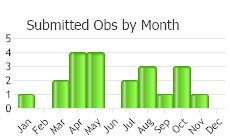
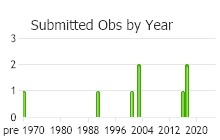
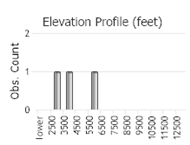 (Observations spanning multiple months or years are excluded from time charts)
(Observations spanning multiple months or years are excluded from time charts)
Habitat
Moist soil, rock, and wood (Elliott 2016), leaf litter (FNA 2014); wet forested habitats (Crum and Anderson et al. 1981). Elevation: 3-9190 feet (FNA 2014).
Reproductive Characteristics
Autoicous. Sporophytes common (FNA 2014). Perigonia located on the stems, frequently close to the perichaetia. Perichaetial leaves lacking costa, the apices squarrose (Lawton 1971). Seta 1.5-3 cm, reddish. Capsule level or strongly tilted, russet, sometimes rounded, 2-2.5 mm in length (FNA 2014).
Stewardship Responsibility
References
- Literature Cited AboveLegend:
 View Online Publication
View Online Publication Crum, H.A. and L.E. Anderson. 1981. Mosses of Eastern North America. 2 volumes. Columbia University Press, New York. 1328 pp.
Crum, H.A. and L.E. Anderson. 1981. Mosses of Eastern North America. 2 volumes. Columbia University Press, New York. 1328 pp. Elliott, J.C. and A.K. Pipp. 2018. A Checklist of Montana Mosses (1880-2018). Updated 3 January, 2020. Montana Natural Heritage Program, Helena, Montana. 73 pp.
Elliott, J.C. and A.K. Pipp. 2018. A Checklist of Montana Mosses (1880-2018). Updated 3 January, 2020. Montana Natural Heritage Program, Helena, Montana. 73 pp. Flora of North America Editorial Committee, eds. 2014. Flora of North America North of Mexico. Volume 28. Bryophytes: Mosses, Part 2. Oxford University Press, Inc., NY. xxi + 702 pp.
Flora of North America Editorial Committee, eds. 2014. Flora of North America North of Mexico. Volume 28. Bryophytes: Mosses, Part 2. Oxford University Press, Inc., NY. xxi + 702 pp. Lawton, E. 1971. Moss Flora of the Pacific Northwest. Hattori Botanical Laboratory. Japan: Yamabuki-cho, Shinjuku-ku, Tokyo. 362 pages plus appendices.
Lawton, E. 1971. Moss Flora of the Pacific Northwest. Hattori Botanical Laboratory. Japan: Yamabuki-cho, Shinjuku-ku, Tokyo. 362 pages plus appendices. Smith, A.J.E. 1980. The Moss Flora of Britain and Ireland. Cambridge University Press, Cambridge. 705 pp.
Smith, A.J.E. 1980. The Moss Flora of Britain and Ireland. Cambridge University Press, Cambridge. 705 pp. Vitt, D. J. Marsh, and R. Bovey. 1988. Mosses, Lichens & Ferns of Northwest North America. Seattle, WA: University of Washington Press. 296 p.
Vitt, D. J. Marsh, and R. Bovey. 1988. Mosses, Lichens & Ferns of Northwest North America. Seattle, WA: University of Washington Press. 296 p.
- Additional ReferencesLegend:
 View Online Publication
View Online Publication
Do you know of a citation we're missing? Elliot, J. C. 1993. Second checklist of Montana mosses. Unpublished report. U.S. Forest Service, Region 1. Missoula, MT. 45 pp.
Elliot, J. C. 1993. Second checklist of Montana mosses. Unpublished report. U.S. Forest Service, Region 1. Missoula, MT. 45 pp. Lawton, E. 1971. Keys for the Identification of the Mosses on the Pacific Northwest. Reprinted from 'Moss Flora of the Pacific Northwest'. Published as Supplement No. 2 of the Journal of the Hattori Botanical Laboratory. Nichinan, Miyazaki, Japan. 66 pp.
Lawton, E. 1971. Keys for the Identification of the Mosses on the Pacific Northwest. Reprinted from 'Moss Flora of the Pacific Northwest'. Published as Supplement No. 2 of the Journal of the Hattori Botanical Laboratory. Nichinan, Miyazaki, Japan. 66 pp.
- Web Search Engines for Articles on "Robust Mat Moss"





